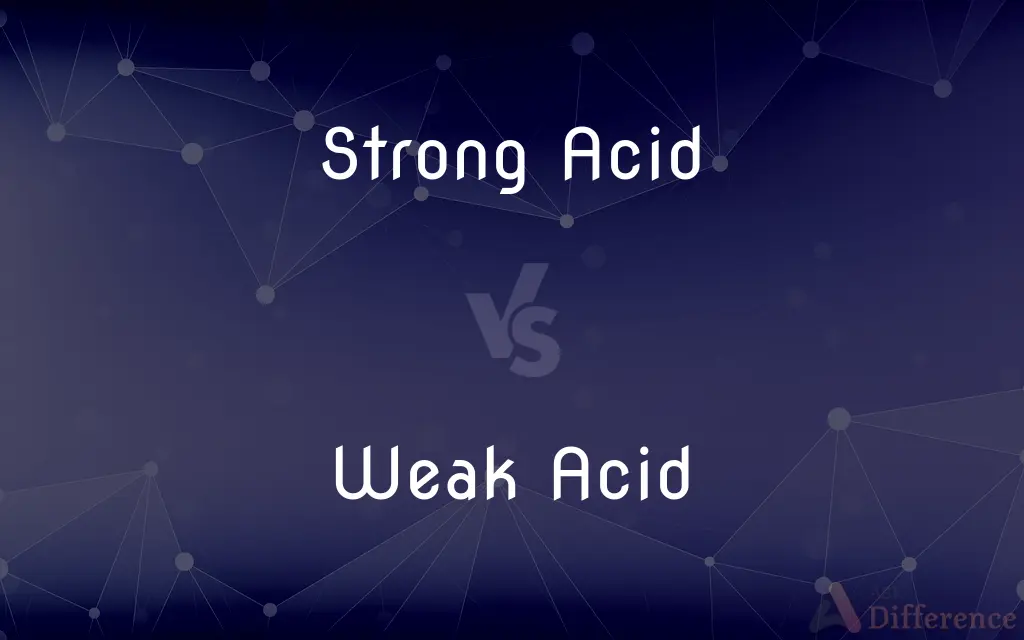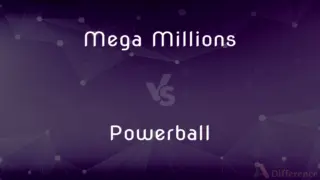Strong Acid vs. Weak Acid — What's the Difference?
By Tayyaba Rehman — Published on December 1, 2023
Strong Acid fully dissociates in water, producing a high concentration of H+ ions, while a Weak Acid only partially dissociates, producing fewer H+ ions.

Difference Between Strong Acid and Weak Acid
Table of Contents
ADVERTISEMENT
Key Differences
A Strong Acid is a substance that, when dissolved in water, fully dissociates to produce hydrogen ions (H+). On the other hand, a Weak Acid does not fully dissociate; only a fraction of its molecules release H+ ions when in solution.
The distinction between a Strong Acid and a Weak Acid lies in their ionization in water. A Strong Acid will ionize completely, ensuring that all its molecules break down. Conversely, a Weak Acid will only achieve partial ionization, with many of its molecules remaining intact.
In terms of pH values, a Strong Acid will have a pH closer to 0, indicating a higher acidity. In contrast, a Weak Acid will possess a pH value that is higher, but still less than 7, reflecting its reduced acidity.
The conductivity of a solution can also provide insights into whether an acid is strong or weak. A solution of a Strong Acid will exhibit higher electrical conductivity due to the greater number of ions present. A Weak Acid solution, with fewer ions, will have a lower conductivity.
To summarize, a Strong Acid fully dissociates in water, making it more reactive and yielding a higher concentration of H+ ions. In contrast, a Weak Acid only partially dissociates, leading to a lower concentration of H+ ions and making it less reactive.
ADVERTISEMENT
Comparison Chart
Degree of Ionization
Fully ionizes in water
Partially ionizes in water
PH Value
Closer to 0
Higher than strong acids but less than 7
Conductivity
High (due to more ions)
Lower (due to fewer ions)
Reactivity
More reactive
Less reactive
Concentration of H+ Ions
High
Low
Compare with Definitions
Strong Acid
Strong Acid has a pH closer to 0.
Sulfuric acid, a Strong Acid, can have a pH value near 0.
Weak Acid
Weak Acid produces a lower concentration of H+ ions in solution.
When phosphoric acid, a Weak Acid, is in water, it releases fewer H+ ions compared to Strong Acids.
Strong Acid
Strong Acid produces a high concentration of H+ ions in solution.
In water, perchloric acid, a Strong Acid, releases a high number of H+ ions.
Weak Acid
Weak Acid does not fully dissociate in water.
Acetic acid, found in vinegar, is a Weak Acid that only partially dissociates.
Strong Acid
Strong Acid solutions exhibit high conductivity.
A solution of nitric acid, a Strong Acid, will conduct electricity well.
Weak Acid
Weak Acid solutions have pH values higher than those of strong acids but less than 7.
Citric acid, a Weak Acid, has a pH value above that of Strong Acids.
Strong Acid
Strong Acid fully dissociates in solution.
Hydrochloric acid (HCl) is a Strong Acid that fully dissociates in water.
Weak Acid
Weak Acid solutions show reduced electrical conductivity.
A solution of formic acid, a Weak Acid, has lower conductivity than a Strong Acid solution.
Strong Acid
Strong Acid is highly reactive with bases.
A Strong Acid like hydrochloric acid reacts vigorously with bases like sodium hydroxide.
Weak Acid
Weak Acid is less reactive than Strong Acids with bases.
Carbonic acid, a Weak Acid, reacts less intensely with bases than Strong Acids do.
Common Curiosities
What is the primary difference between a Strong Acid and a Weak Acid?
A Strong Acid fully dissociates in water, while a Weak Acid only partially dissociates.
Are Weak Acids less reactive than Strong Acids?
Yes, Weak Acids are generally less reactive than Strong Acids.
Are the terms "dilute" and "Weak Acid" synonymous?
No, "dilute" refers to concentration, while "Weak Acid" refers to the degree of ionization.
Are all Strong Acids dangerous to handle?
While not all are equally hazardous, many Strong Acids can be harmful and require careful handling.
Do Strong Acids have a pH value close to 0?
Yes, Strong Acids tend to have pH values closer to 0.
Which type of acid exhibits higher electrical conductivity in solution?
A Strong Acid shows higher conductivity due to more ions.
Is hydrochloric acid a Strong Acid or a Weak Acid?
Hydrochloric acid is a Strong Acid.
Do all acids have a sour taste?
Typically, both Strong and Weak Acids can have a sour taste, but tasting is not a recommended method of identification.
What determines the strength of an acid?
The strength of an acid is determined by its ability to donate protons (H+ ions) in a solution.
Can a Weak Acid ever have a pH value below 7?
Yes, a Weak Acid can still be acidic and have a pH below 7, but not as low as Strong Acids.
Is acetic acid considered a Strong Acid or a Weak Acid?
Acetic acid is considered a Weak Acid.
How can I differentiate between a Strong Acid and a Weak Acid using pH paper?
A Strong Acid will give a pH value closer to 0, while a Weak Acid will show a higher pH, though still below 7.
Can the strength of an acid change under different conditions?
Generally, the intrinsic strength of an acid won't change, but factors like concentration and temperature can affect its behavior in solution.
Can a Strong Acid exist in a dilute solution?
Yes, a Strong Acid can be in a dilute solution; its strength refers to ionization, not concentration.
Are Weak Acids always safe to handle?
Not necessarily. Even if they're less reactive, some Weak Acids can still be harmful or corrosive.
Share Your Discovery

Previous Comparison
Cardigans vs. Sweaters
Next Comparison
Mega Millions vs. PowerballAuthor Spotlight
Written by
Tayyaba RehmanTayyaba Rehman is a distinguished writer, currently serving as a primary contributor to askdifference.com. As a researcher in semantics and etymology, Tayyaba's passion for the complexity of languages and their distinctions has found a perfect home on the platform. Tayyaba delves into the intricacies of language, distinguishing between commonly confused words and phrases, thereby providing clarity for readers worldwide.












































